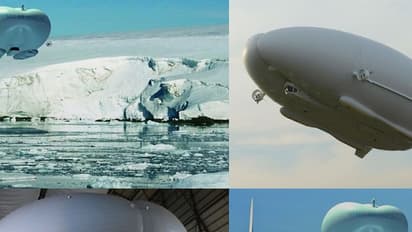Flying Bum will fly again: 5 Reasons why it can change air transport forever

Synopsis
Airlander or Flying Bum is a Hybrid Air Vehicle capable of carrying ten tonne of payload. The Flying Bum can stay airborne for nearly five days. It doesn't require a runway and can land on or take off.
Hybrid technology that can carry 10 tonne of payload
Airlander or Flying Bum is a hybrid aircraft, which is way larger than the traditional aircrafts and cargo airships. It is called hybrid because of the mix of helicopter, plane and airship technologies used. The Airlander 10 weights 20,000kgs and can carry payload up to half its weights - 10 tonne (10,000kgs). It also has a bigger brother called Airlander 50 with 50 tonne of payload capability.
It is payload flexible that can carry anything from containers, infrastructure, cargo, people and combinations. This means revolutionising cargo delivery. It is designed to withstand extreme weather conditions too. The passenger or payload area measures 3.2m x 7.2m x 1.7m, but it can be larger area on the production version.
Video source: Dean Media Ltd
Capable of going to unimaginable places, rescue and search operations
Apart from cargo deliveries in intense weather conditions, it could double as a great option for rescue and search operations. It is designed keeping military in mind. The Airlander 10 requires little to no infrastructure as the Air Cushion Landing System lets it hover over land, snow, ice and even water. It can land as well as take off from any flat surface. Using suction, it could stand stationary during loading and unloading.
Eco-friendly and cheaper
It comes with an environmentally friendly benchmark for air transport and logistics. This means it requires somewhere between 20% and 40% of the fuel consumption and operating costs compared to traditional aircraft. The rotary wing functionality with fixed wing range combined helps reduce operating costs. It requires far less ground crew than a traditional airship. It lands as a conventional aircraft when heavy and can power itself down on the ground when light.
Can stay afloat in air for 5 days
The Airlander 10 uses lighter-than-air technology to fly. The buoyancy which means the ability to float is created by the hull that is filled with helium. In fact, 60 percent of the lift is produced aerostatically, while the remaining 40 percent by the wing shaped hull. Helium, an inert gas, is not flammable and so does not pose any form of risk, unlike the original hydrogen filled airships.
Gives rise to a host of future possibilities
With 1 pilot station and one observer, it is capable of cruising at 148 km/hr and loitering at 37 km/hr. This largest aircraft currently flying uses innovative technology to combine the best characteristics of fixed wing aircraft and helicopters with lighter-than-air technology can go for over 2 weeks unmanned. The lower carbon footprint than other forms of air transport combined with its other possibilities gives rise its use in varying situations including luxury, premium vacation.
Find the latest Technology News covering Smartphone Updates, AI (Artificial Intelligence) breakthroughs, and innovations in space exploration. Stay updated on gadgets, apps, and digital trends with expert reviews, product comparisons, and tech insights. Download the Asianet News Official App from the Android Play Store and iPhone App Store for everything shaping the future of technology.